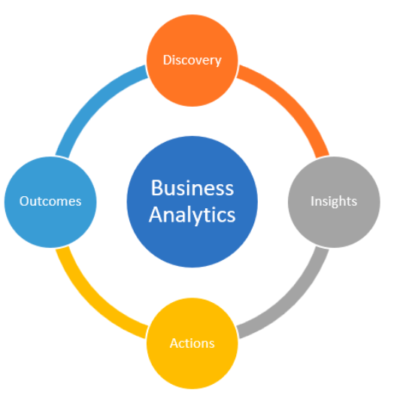What is Business Analytics – Auriga
- General
What is Business Analytics – Auriga
What is Business Analytics:
Business Analytics is the process by which businesses use statistical methods and technologies for analyzing historical data in order to gain new insight and improve strategic decision-making.
Life Cycle of Business Analytics:
Types of Business Analytics:
1. Descriptive analytics: Descriptive analytics is a statistical method that is used to search and summarize historical data in order to identify patterns or meaning
2. Diagnostic Analysis: Diagnostic analysis takes the insights found from descriptive analytics and drills down to find the causes of those outcomes. Organizations make use of this type of analytics as it creates more connections between data and identifies patterns of behavior
3. Predictive analytics: Predictive analytics is a form of technology that makes predictions about certain unknowns in the future on the basis of previous data.
4. Prescriptive analytics: Prescriptive analytics is a process that analyzes data and provides instant recommendations on how to optimize business practices to suit multiple predicted outcomes
Elements of Good Data Visualization
- Clear Headings and Keys
- Relevant Comparison
- Summaries of Key Points
- Comparison of Averages
Type of Data
- Texual, Numerical data: Data that is in the form of numbers and text
- Quantitative data: Quantitative data is the type of data whose value is measured in the form of numbers or counts, with a unique numerical value associated with each data set or you can say fix value in between range for eg Age
- Categorial Data: Data which may be divided into groups. Examples of categorical variables are race, sex, age group etc, it can be divided in two parts.
- Nominal Data: Nominal data (also known as nominal scale) is a type of data that is used to label variables without providing any quantitative value
- Ordinal data: Ordinal data is a kind of categorical data with a set order or scale to it
What is data visualization?
Data visualization is the practice of converting raw information (text, numbers, or symbols) into a graphic format. The data is visualized with a clear purpose: to show logical correlations between units, and define inclinations, tendencies, and patterns
Common types of data Visualizations
- Bar chart: A bar chart is one of the basic ways to compare data units to each other
- Pie chart: A pie chart is a basic way to show ratio over different entities
- Line Graph: This type of visual utilizes a horizontal axis and a vertical axis to depict the value of a unit over time
- Box plot: A box plot looks pretty complicated. But if we look closer at the example, it becomes evident that it depicts quarters in a horizontal fashion
- Scatter plot: This type of visualization is built on X and Y axes. Between them, there are dots placed around, defining objects. The position of a dot on the graph denotes which qualities it has
- Word cloud:An image composed of words used in a particular text or subject, in which the size of each word indicates its frequency or importance.
Related content
Auriga: Leveling Up for Enterprise Growth!
Auriga’s journey began in 2010 crafting products for India’s

